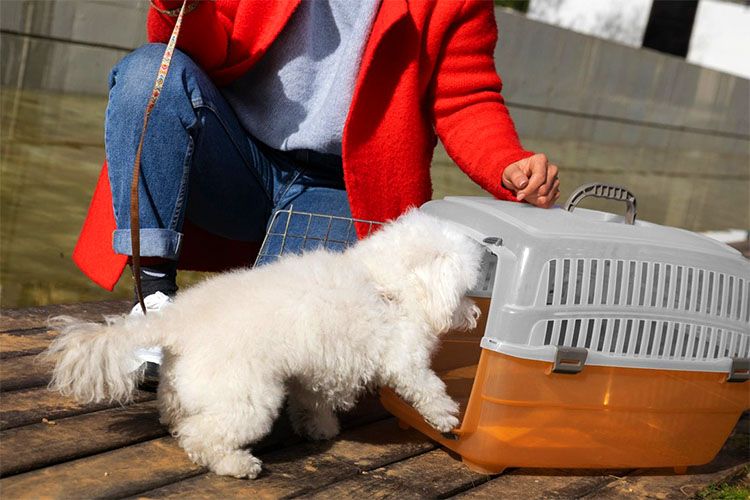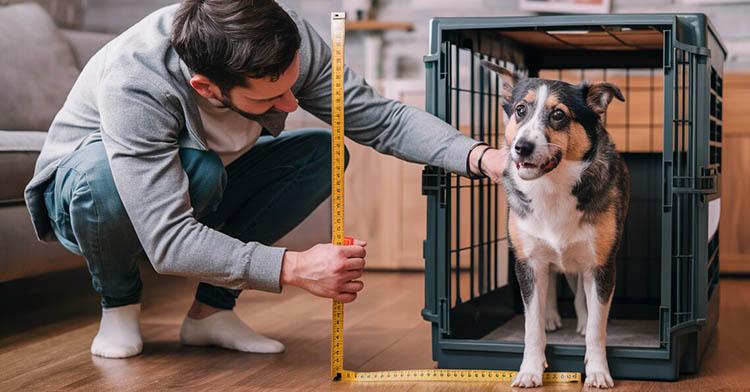Contents
- 1 Why is it Important to Measure a Dog for Crate Fit?
- 2 What Are the Factors to Consider When Measuring a Dog for Crate Fit?
- 3 What Are the Steps to Measure a Dog for Crate Fit?
- 4 How to Choose the Right Crate Size for a Dog?
- 5 How to Ensure a Proper Fit for a Dog’s Crate?
- 6 What Are the Benefits of Properly Fitting a Dog’s Crate?
- 7 Frequently Asked Questions
Ensuring your pet’s comfort and safety is essential, and understanding how to measure a dog for crate fit is a key part of selecting the appropriate crate size.
A well-fitted crate not only provides a comfortable space for your dog but also helps prevent injuries and facilitates successful crate training.
This guide aims to elucidate the significance of measuring your dog for an appropriate crate fit, the key factors to consider in this process, and the necessary steps to determine the optimal size.
By grasping these elements, you will be able to establish a secure and welcoming environment for your canine companion.
Why is it Important to Measure a Dog for Crate Fit?
Measuring a dog for proper crate fit is a fundamental responsibility of pet ownership that ensures both safety and comfort for the canine companion.
A correctly sized crate provides a secure environment while also encouraging positive behavior by allowing sufficient space for the dog to lie down, stand up, and turn around with ease.
When selecting a crate, it is important to consider the dog’s height, length, and width, in addition to breed characteristics and weight. This careful consideration is essential for effective crate training and can significantly influence the overall well-being of the dog.
What Are the Factors to Consider When Measuring a Dog for Crate Fit?

When measuring a dog for an appropriate crate fit, it is essential to take into account several factors that can influence the optimal size and type of crate. These factors include the dog’s height, length, width, and weight, as well as breed characteristics and activity level.
Each of these elements is critical in determining the best crate options for the dog, ensuring that there is sufficient space for comfortable movement without compromising their sense of security. Additionally, considerations regarding the dog’s age and developmental stage should be made to ensure long-term suitability.
1. Size of the Dog
The size of the dog is a critical factor to consider when selecting a crate, as it significantly impacts the dog’s comfort and mobility.
Understanding the breed size and overall weight will facilitate the identification of appropriate crate dimensions for a proper fit, which is vital for both safety and well-being.
To measure effectively, it is recommended to use a soft measuring tape, preferably the type used in sewing, as it can easily conform to the dog’s body.
Begin by measuring the dog’s height from the ground to the top of the head while the dog is standing straight. Next, measure the length from the tip of the nose to the base of the tail. For width, measure the widest part of the body, typically across the chest.
These measurements should inform the selection of a crate with adequate space – an incorrect size can result in anxiety, restricted movement, and even potential injury.
Dogs that feel confined in a crate may develop negative associations with the space, leading to stress and behavioral issues, making it imperative to obtain precise measurements.
2. Breed of the Dog
The breed of the dog significantly influences the appropriate size and type of crate, as different breeds possess unique characteristics and requirements. For instance, larger breeds such as Great Danes necessitate more spacious indoor crates, while smaller breeds like Chihuahuas require just enough room to feel secure.
A comprehensive understanding of the breed’s traits, including typical posture and lounging behaviors, enables dog owners to make informed decisions regarding crate selection that address their pets’ specific needs.
Certain breeds, including Greyhounds, may benefit from crates that allow for comfortable stretching due to their elongated body structure, whereas more active breeds, such as Border Collies, often prefer crates that facilitate easy movement and adequate ventilation.
Wire crates are favored by many dog owners as they provide proper airflow and visibility – however, solid-sided crates can offer a greater sense of security for more anxious breeds.
When considering how to measure a dog for crate fit, it’s important to understand that while wire crates are favored by many dog owners for their proper airflow and visibility, solid-sided crates can offer a greater sense of security, especially for more anxious breeds.
Ultimately, aligning the style of the crate with the individual characteristics of each breed not only ensures comfort for the pet but also considers their behavioral tendencies, thereby making the process of crate training a more effective and positive experience.
3. Age of the Dog
The age of the dog is a crucial factor to consider when determining the appropriate crate size, as puppies and adult dogs have differing space requirements. Puppies experience rapid growth, so a crate that is suitable for them at one stage may require adjustment as they transition into adulthood.
It is vital to select a crate that provides adequate room for growth while avoiding excessive space, as this can lead to anxiety or confusion during crate training.
When selecting a crate, prospective owners must prioritize comfort and safety. For puppies, incorporating a divider can be beneficial, allowing for a snug fit while accommodating their rapid growth.
Conversely, adult dogs necessitate sufficient space to comfortably stand, turn around, and lie down without feeling constrained.
Additionally, considerations such as crate materials and ventilation are essential to ensure a safe environment that promotes relaxation. Ultimately, the ideal crate should not only function as a secure haven but also foster a sense of safety and comfort, thereby facilitating successful training and bonding.
4. Activity Level of the Dog
The activity level of a dog significantly influences its crate requirements, as energetic dogs may necessitate more space to move or additional accessories to enhance their comfort.
High-energy breeds typically benefit from larger crates that provide sufficient space for jumping and playing, while less active breeds may find contentment in smaller, cozier environments. Understanding a dog’s behavioral patterns can lead to improved crate comfort and contribute positively to overall pet welfare.
When selecting a crate for an active dog, it is essential to consider not only the size but also the inclusion of engaging elements such as toys or chew-proof blankets to alleviate boredom. This approach can help prevent anxiety and promote a positive association with the crate, transforming it into a safe haven rather than a mere confinement.
Additionally, implementing training techniques that reward calm behavior inside the crate can assist in the dog’s adjustment period, fostering a sense of security during times spent alone.
Understanding how to measure a dog for crate fit is essential, as a well-designed crate environment plays a crucial role in shaping your dog’s comfort and sense of belonging.
What Are the Steps to Measure a Dog for Crate Fit?
Measuring a dog for appropriate crate fit involves several straightforward steps that ensure the selection of the correct size crate for the pet.
- First, obtain a measuring tape and have the dog stand in a relaxed position;
- Measure the dog’s length from the tip of the nose to the base of the tail;
- Next, measure the height from the ground to the top of the head while the dog is standing;
- Finally, measure the width by assessing the distance across the widest part of the dog’s body.
By adhering to these steps, one can achieve an accurate crate fitting guide that meets the dog’s specific needs.
1. Measure the Length of the Dog
To accurately measure the length of your dog, begin by having them stand upright on a flat surface. Utilize a measuring tape to determine the distance from the tip of the dog’s nose to the base of their tail.
This measurement is essential for selecting the appropriate crate size, as it dictates the amount of space required for your dog to lie down comfortably.
For enhanced precision, it is advisable to enlist the assistance of a friend, who can gently hold the dog’s head in place while you extend the tape along the body. Employing treats can also be an effective strategy to keep your pet still during this process, transforming the task into a more engaging experience rather than a chore.
It is important to minimize any distractions in the environment that may cause your dog to shift or move unexpectedly.
The significance of this measurement cannot be overstated – knowing how to measure a dog for crate fit is crucial, as an ill-fitting crate could lead to discomfort and anxiety for your pet.
2. Measure the Height of the Dog
Measuring the height of a dog involves determining the distance from the ground to the top of the dog’s head while in a standing position.
It is recommended to utilize a measuring tape to obtain this measurement, ensuring that the dog is standing straight and relaxed. This height measurement is essential for selecting a crate that permits the dog to stand comfortably.
Achieving an accurate height measurement is critical, as it directly affects the selection of the appropriate crate size. To ensure reliability, it is advisable to take at least two measurements, ideally from different angles, to account for any slight variations in posture or positioning.
A dog that feels confined within a crate is likely to experience unnecessary stress, which can negatively impact their overall comfort and well-being.
Therefore, accurately measuring their height not only ensures adequate space for the dog to stand and turn around but also significantly contributes to their sense of safety and security while inside the crate.
3. Measure the Width of the Dog
To measure the width of your dog, utilize a measuring tape to ascertain the distance across the widest part of their body, which is typically around the chest area. To ensure that the crate provides enough space for your dog to lie comfortably without feeling confined, understanding how to measure a dog for crate fit is essential.
For an accurate measurement, it is important to ensure that the dog is standing straight and relaxed, as this will yield a more precise reading. Gently wrap the measuring tape around the area just behind the front legs, taking care not to pull too tightly.
It may be beneficial to have someone assist in holding the dog still during this process to prevent any movement that could lead to inaccuracies.
Additionally, considering the dog’s sleeping habits – whether they prefer to curl up or stretch out – can influence the width requirements. By obtaining a precise width measurement, you can select a crate that enhances your dog’s overall comfort and well-being, ensuring they have a safe and secure space to relax.
How to Choose the Right Crate Size for a Dog?

Selecting the appropriate crate size for a dog is crucial for ensuring their comfort and security, as it significantly affects their overall well-being during crate training and throughout pet ownership.
When purchasing a crate, it is advisable to consult the manufacturer’s guidelines, which offer specific size recommendations based on the dog’s measurements.
Furthermore, it is essential to evaluate the dog’s needs, including their behavioral characteristics and growth potential, in order to choose a crate that provides both short-term and long-term comfort.
1. Follow the Manufacturer’s Guidelines
Adhering to the manufacturer’s guidelines is essential when selecting a crate for a dog, as these guidelines provide critical information regarding appropriate crate dimensions based on factors such as breed size and weight.
Each crate model may present specific recommendations tailored to different dog breeds, ensuring that the pet receives a safe and comfortable environment.
By following these guidelines on how to measure a dog for crate fit, pet owners can avoid common mistakes that may lead to the selection of incorrect sizes or types of crates, which can result in discomfort or safety hazards.
A properly sized crate enables a dog to stand, turn around, and lie down comfortably, thereby reducing anxiety and fostering a sense of security.
Comprehending the recommended materials and designs is instrumental in making an informed decision regarding the ideal crate for specific requirements, whether it be for travel, training, or long-term use. This deliberate approach not only enhances the well-being of the pet but also contributes to a harmonious home environment.
2. Consider the Dog’s Weight and Measurements
When selecting a crate, it is essential to consider both the dog’s weight and measurements to ensure an appropriate fit. A crate that is too small may cause discomfort and anxiety, whereas one that is excessively large may result in feelings of insecurity for the dog.
It is important to ensure that the crate allows the dog to stand, sit, and lie down comfortably without restriction.
Evaluating crate dimensions in relation to the dog’s weight can greatly facilitate the selection process. For example, ensuring adequate space for breeds with longer bodies or larger sizes is critical.
A useful guideline is to provide a crate that offers approximately three to five inches of headroom above the dog when standing, along with sufficient space for the dog to turn around without making contact with the sides.
Breed-specific recommendations can provide valuable guidance to owners, as different breeds possess varying spatial requirements based on their physical build. Consulting size charts that are tailored for specific breeds can further assist in identifying the ideal crate, thereby enhancing the dog’s comfort and security.
3. Consider the Dog’s Behavior and Comfort Level
Considering a dog’s behavior and comfort level is paramount when selecting a crate, as it significantly impacts their adaptation to a new environment.Dogs that exhibit signs of anxiety or stress may require a crate that offers a snug fit to foster a sense of security.
Conversely, those that are more relaxed may thrive in a larger space that allows for lounging. It is essential to assess these behavioral patterns in order to make an informed decision.
Observing a dog’s interactions with various spaces within the home can provide valuable insights into their crate preferences. For example, a dog that favors den-like environments may be more inclined to prefer a covered crate, while one that seeks open areas might find a wire crate, which allows them to remain visible and engaged in family activities, to be more comfortable.
Attention should be given to how a dog reacts to the crate during the introduction phase – signs of curiosity or hesitation are critical indicators of their comfort level.
Understanding these behavioral cues not only enhances the dog’s comfort within the crate but also plays a crucial role in promoting their overall welfare during the crate training process, especially when considering how to measure a dog for crate fit.
How to Ensure a Proper Fit for a Dog’s Crate?
Ensuring an appropriate fit for a dog’s crate is crucial for their comfort and safety, as it directly influences their ability to relax and adapt to crate training. The crate should provide sufficient space for the dog to stand, turn around, and lie down comfortably, while also offering a secure environment that supports the dog’s natural posture.
By adhering to specific crate safety guidelines, one can significantly enhance the overall experience for the dog during crate usage.
1. Make Sure the Dog Can Stand, Sit, and Turn Comfortably
One of the primary considerations for ensuring an appropriate fit for a dog crate is to confirm that the dog can comfortably stand, sit, and turn around within the crate. This is essential for maintaining the dog’s natural posture and preventing physical strain, which can lead to anxiety and discomfort during crate usage.
Cramped living conditions can significantly affect a dog’s mental well-being, contributing to heightened stress levels and behavioral issues. Similar to humans, dogs require personal space to feel secure and thrive in environments that allow for free movement.
It is imperative to assess the crate size according to the breed and specific needs of the dog, ensuring that there is sufficient space for various postures, such as lying down comfortably or stretching out.
Additionally, pet owners should implement safety measures, including regularly inspecting the crate environment for potential hazards and ensuring that the space is made cozy with familiar items, such as a favorite blanket or toy, to foster a sense of security.
2. Leave Adequate Space for Bedding and Toys
Ensuring comfort and fostering positive crate experiences for dogs involves providing adequate space for bedding and toys within the crate. Understanding how to measure a dog for crate fit is crucial in achieving the right balance, ensuring your pet has the room they need to feel secure and comfortable.
A cozy environment that includes familiar accessories can help dogs feel secure and alleviate anxiety, thereby enhancing the effectiveness of crate training.
Incorporating dog accessories such as soft bedding and engaging toys can significantly improve this safe space, effectively transforming the crate into a personal sanctuary. The presence of these elements not only promotes relaxation but also contributes to making the crate a desirable retreat for dogs.
When the crate is equipped with comforting bedding, it absorbs the dog’s scent, further establishing it as a safe haven. Additionally, toys serve to provide mental stimulation and entertainment, turning quiet time into a positive experience.
Ultimately, creating a comforting and inviting crate environment can lead to happier, more content dogs.
3. Check for Any Sharp Edges or Protruding Objects
Before introducing a dog to a new crate, it is crucial to inspect the crate for any sharp edges or protruding objects that may pose a risk to the animal’s safety.
A thorough examination of the materials and construction of the crate is necessary to ensure that it is free from potential hazards that could lead to injury during use.
Taking the time to conduct comprehensive safety checks not only helps to prevent accidents but also fosters a sense of security for the pet. By ensuring that the materials used in the crate are non-toxic and durable, pet owners can confidently provide a safe environment for their animals.
Gradually familiarizing a dog with its new space can mitigate anxiety and promote positive associations, transforming the crate into a comforting retreat rather than a source of stress.
Emphasizing these steps underscores the significance of pet safety and nurtures a trusting relationship between the owner and the pet.
What Are the Benefits of Properly Fitting a Dog’s Crate?

Properly fitting a dog’s crate offers numerous benefits that enhance both the dog’s well-being and the owner’s peace of mind. A correctly sized crate ensures that the dog feels safe and secure, which minimizes anxiety and promotes positive behaviors.
Additionally, it facilitates effective crate training, assisting the dog in adapting to their environment and establishing a sense of routine. These advantages collectively contribute to the overall welfare and safety of the pet.
1. Prevents Injuries and Discomfort
A properly fitted crate is essential in preventing injuries and discomfort for dogs, as an ill-fitting crate can lead to physical strain or create hazardous situations. Ensuring that the crate is of appropriate size significantly reduces the risk of injuries associated with excessive movement or the inability to change positions comfortably.
When a crate is too small, it restricts a dog’s natural movements, compelling them into awkward positions that may result in muscle soreness or joint issues over time.
Conversely, a crate that is excessively large may encourage a dog to engage in unnecessary bouncing or tumbling, thereby increasing the likelihood of scrapes or falls.
By selecting a crate with the correct dimensions, pet owners not only enhance their dogs’ comfort but also contribute to their overall well-being. To ensure a secure and relaxing environment that fosters better rest and recovery – essential for a healthy lifestyle – it’s important to understand how to measure a dog for crate fit.
2. Promotes Safe and Comfortable Travel
A well-fitted crate is essential for ensuring safe and comfortable travel for dogs, providing a secure environment during car rides or extended journeys. When traveling, a properly sized crate allows dogs to maintain mobility without feeling cramped, thereby reducing the likelihood of anxiety and restlessness.
A correctly sized crate enables the pet to stand, lie down, and turn around comfortably, which minimizes stress and enhances the overall travel experience. This aspect of crate safety is critical not only for the well-being of the dog but also for the safety of the vehicle’s occupants.
A dog that is securely housed in a well-fitted crate is less likely to shift unexpectedly during sudden stops or turns, thereby preventing potential distractions for the driver.
Ultimately, selecting a crate that is appropriate for the dog’s size and breed significantly contributes to a smoother journey, offering peace of mind for both the pet and their owner while on the road.
3. Helps with Crate Training and Housebreaking
A properly fitted crate is essential for crate training and housebreaking, as it plays a significant role in a dog’s ability to adapt to its new environment. A crate that provides adequate space promotes positive associations and reduces anxiety, thereby facilitating the learning process associated with crate usage.
Selecting the appropriate crate size is crucial – it should be large enough for the dog to stand up, turn around, and lie down comfortably, yet small enough to discourage the animal from using one corner as a bathroom. This balance encourages the dog to hold its bladder until taken outside, thereby reinforcing desirable habits.
In addition to providing a well-sized crate, implementing consistent schedules for feeding and bathroom breaks is essential in establishing a routine, which is crucial when learning how to measure a dog for crate fit, further enhancing the pet’s comfort.
Positive reinforcement, such as praise or treats, can significantly improve the training experience, fostering a healthy relationship with the crate and promoting successful housebreaking efforts.

